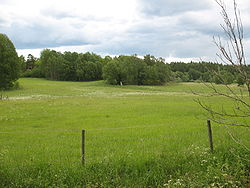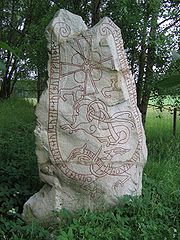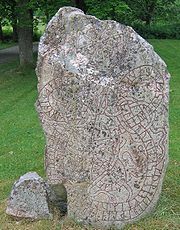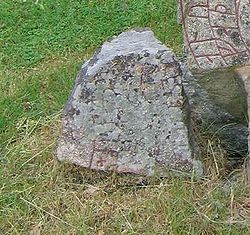
Lingsberg Runestones
Encyclopedia

Rundata
The Scandinavian Runic-text Data Base is a project involving the creation and maintenance of a database of runic inscriptions. The project's goal is to comprehensively catalog runestones in a machine-readable way for future research...
catalog, and one fragment, U 242, that are engraved in Old Norse
Old Norse
Old Norse is a North Germanic language that was spoken by inhabitants of Scandinavia and inhabitants of their overseas settlements during the Viking Age, until about 1300....
using the younger futhark
Younger Futhark
The Younger Futhark, also called Scandinavian runes, is a runic alphabet, a reduced form of the Elder Futhark, consisting of only 16 characters, in use from ca. 800 CE...
and located at the farm at Lingsberg, which is about two kilometers northeast of Vallentuna
Vallentuna
Vallentuna is a bimunicipal locality and the seat of Vallentuna Municipality, Stockholm County, Sweden with 26,500 inhabitants in 2005. It stretches over two municipalities in Stockholm County, in the Roslagen region. Vallentuna is also a suburb of Stockholm...
, Stockholm County
Stockholm County
Stockholm County is a county or län on the Baltic sea coast of Sweden. It borders Uppsala County and Södermanland County. It also borders Mälaren and the Baltic Sea. The city of Stockholm is the capital of Sweden. Stockholm County is divided by the historic provinces of Uppland and Södermanland...
, Sweden
Sweden
Sweden , officially the Kingdom of Sweden , is a Nordic country on the Scandinavian Peninsula in Northern Europe. Sweden borders with Norway and Finland and is connected to Denmark by a bridge-tunnel across the Öresund....
, which was part of the former province of Uppland
Uppland
Uppland is a historical province or landskap on the eastern coast of Sweden, just north of Stockholm, the capital. It borders Södermanland, Västmanland and Gästrikland. It is also bounded by lake Mälaren and the Baltic sea...
.
The two intact runestones were raised by members of the same family, and on U 241 they engraved for posterity that a grandfather had taken two danegeld
Danegeld
The Danegeld was a tax raised to pay tribute to the Viking raiders to save a land from being ravaged. It was called the geld or gafol in eleventh-century sources; the term Danegeld did not appear until the early twelfth century...
s in England
England
England is a country that is part of the United Kingdom. It shares land borders with Scotland to the north and Wales to the west; the Irish Sea is to the north west, the Celtic Sea to the south west, with the North Sea to the east and the English Channel to the south separating it from continental...
. Because the receipt of the danegeld indicates likely service with the Scandinavia
Scandinavia
Scandinavia is a cultural, historical and ethno-linguistic region in northern Europe that includes the three kingdoms of Denmark, Norway and Sweden, characterized by their common ethno-cultural heritage and language. Modern Norway and Sweden proper are situated on the Scandinavian Peninsula,...
n troops in the Thingmen from 1018 to 1066, the runestones are dated to the second quarter of the 11th century.
U 240

Causeway
In modern usage, a causeway is a road or railway elevated, usually across a broad body of water or wetland.- Etymology :When first used, the word appeared in a form such as “causey way” making clear its derivation from the earlier form “causey”. This word seems to have come from the same source by...
facing U 241. Today, the causeway is only seen as traces in a field, and U 240 is the only runestone present. The area was much more marshy in the past and difficult to traverse until the water level in a local lake named Angarn was lowered in the 19th century. The inscription consists of runic text on two serpents or lindworm
Lindworm
Lindworm in British heraldry, is a technical term for a wingless bipedal dragon often with a venomous bite.-Etymology:In modern Scandinavian languages, the cognate lindorm can refer to any 'serpent' or monstrous...
s that bracket a Christian cross
Christian cross
The Christian cross, seen as a representation of the instrument of the crucifixion of Jesus Christ, is the best-known religious symbol of Christianity...
and some beasts. The final portion of the text that translates as "and Holmfríðr in memory of her husbandman" is carved on the outside of the serpent to the right. U 240 is classified as being carved in runestone style
Runestone styles
The runestone styles varied during the Viking Age. The early runestones were simple in design, but towards the end of the runestone era they became increasingly complex and made by travelling runemasters such as Öpir and Visäte....
Pr3, which is also known as Urnes style
Urnes style
The Urnes style was the last phase of Scandinavian animal art during the second half of the 11th century and in the early 12th century. The preceding phases of Scandinavia's Viking Age animal ornamentation are usually categorized as Oseberg style, Borre style, Jelling style, Mammen style and...
, and is considered to be a good example of an inscription in style Pr3. This runestone style is characterized by slim and stylized animals that are interwoven into tight patterns. The animal heads are typically seen in profile with slender almond-shaped eyes and upwardly curled appendages on the noses and the necks. The runic text on U 240 was intended to be read together with that on U 241 to form a unified message. Based on stylistic analysis, the inscription has been attributed to the runemaster
Runemaster
A runemaster or runecarver is a specialist in making runestones.Most early medieval Scandinavians were probably literate in runes, and most people probably carved messages on pieces of bone and wood. However, it was difficult to make runestones, and in order to master it one also needed to be a...
Åsmund
Åsmund Kåresson
Åsmund Kåresson was a Viking Age runemaster who flourished during the first half of the 11th century in Uppland and Gästrikland, Sweden. The early Urnes style is represented in his art.-Work:...
, who was active in the first part of the 11th century.
Latin transliteration:
- tan auk hus(k)arl + auk suain + auk hulmfriþr × þaun (m)(i)(þ)kin litu rita stin þino × aftiR halftan + fa(þ)ur þaiRa tans ' auk hum(f)riþr at buanta sin
Old Norse transcription:
- Dan ok Huskarl ok Svæinn ok Holmfriðr, þaun møðgin letu retta stæin þenna æftiR Halfdan, faður þæiRa Dans, ok Holmfriðr at boanda sinn.
English translation:
- Danr and Húskarl and Sveinn and Holmfríðr, the mother and (her) sons, had this stone erected in memory of Halfdan, the father of Danr and his brothers; and Holmfríðr in memory of her husbandman.
U 241

The runic text mentions Húskarl and Sveinn like U 241, except for Holmfríðr, and it adds Halfdan's father Ulfríkr, who had taken two danegelds in England. Unfortunately, it does not mention which leaders paid the danegelds, unlike the other two runestones located in Uppland that talk of danegelds, U 344 and U 194. As noted above, the runic text of U 240 and U 241 were intended to be read together to form a unified message, with the text on U 241 beginning with the Old Norse word en meaning "and."
It was common to only carve a single rune for two consecutive letters, even when the letters were at the end of one word and the beginning of a second word. When the text shown as Latin characters, the transliterated
Runic transliteration and transcription
Runic transliteration and transcription are part of analysing a runic inscription which involves transliteration of the runes into Latin letters, transcription into a normalized spelling in the language of the inscription, and translation of the inscription into a modern language...
runes are doubled and separate words are shown. U 241 has three examples in its runic text where this occurred. The runes onklanti are transliterated as o| |onklanti, kialtakit as kialt| |takit, and salukuþs as salu| |uk| |kuþs.
Latin transliteration:
- n tan auk huskarl ' auk sua(i)n ' l(i)tu rita stin aftiR ' ulfrik ' faþurfaþur sino ' hon hafþi o| |onklanti tuh kialt| |takit + kuþ hialbi þiRa kiþka salu| |uk| |kuþs muþ(i)
Old Norse transcription:
- En Dan ok Huskarl ok Svæinn letu retta stæin æftiR Ulfrik, faðurfaður sinn. Hann hafði a Ænglandi tu giald takit. Guð hialpi þæiRa fæðga salu ok Guðs moðiR.
English translation:
- And Danr and Húskarl and Sveinn had the stone erected in memory of Ulfríkr, their father's father. He had taken two payments in England. May God and God's mother help the souls of the father and son.
U 242

Latin transliteration:
- - × auk × st[u]... ... ...- × (r)(a)(i)(s)(a) × ...
Old Norse transcription:
- ... ok ... ... ... ræisa ...
English translation:
- ... and ... ... ... raise ...
Sources
- Sveriges runinskrifter, by Erik Brate (1922)
- Christer Hamp's page on runestones.

